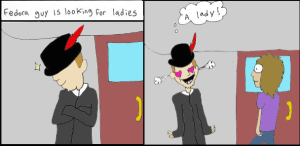Like my sweatshirt? They’re sexual identities. Most of them are prefixes, meaning a few letters or short words added to another word to change its meaning.
Prefixes, like hetero, which means “different or other” and homo, which means “the same.” When we add them to the word sexual, they become heterosexual, as in attracted to a different sex and homosexual, as in attracted to the same sex. And those are just two off the list! Let’s go through the rest, so when you’re wearing this sweatshirt, you can teach the curious.
Up here is pomo. Pomo stands for post-modern. Essentially, a pomosexual expresses an identity that challenges labels based on sexual attraction and preferences. Sexologist Carol Queen coined it and wrote a book by the same name, Pomosexuals. In her words, the problem with any ascribed and adopted identity is not what it includes, but what it leaves out. Pomosexuality doesn’t leave anyone out because there’s no “in.”
Inter: Inter as a prefix means “between.” As a sexual identity, intersex refers to the anatomical, chromosomal, and hormonal bodies between male and female. I love how the Intersex Society of North America puts it, “Nature doesn’t decide where the category of male ends and the category of intersex begins, or where the category of intersex ends and the category of female begins. Humans decide.”
Poly, as in this video (points to a video link on the screen). Polygamous, polyandrous, polyamorous – relationship dynamics with more than one partner in love, marriage, and/or sex.
Andro: Androsexuals are attracted to males, men, and/or masculinity. As in, “I never really know what someone is packing when the attraction starts, so it’s not about the penis or the vagina. It’s about how the person expresses—and, whew, hot!”
Gyne, or gynesexual, referring to attraction toward females, women, and/or femininity.
Andro and gyne together: androgyny. This is when a person presents a lot of masculinity and femininity, like Ruby Rose. The opposite of this is undifferentiated, neutois, gender neutral, and or agender.
A, a meaning without – without gender, without orientation, without attraction, without sex. Specifically, asexuality is the absence of sexual attraction – this video (points to a link on the screen).
Gray A is A sometimes, under certain conditions, or yes there’s attraction, but low or no desire to even act on it.
Demisexual would be one of those gray A circumstances when the sexual attraction isn’t there unless there’s a strong emotional connection.
Trans – this video – a prefix meaning “across, beyond, or on the opposite side.” Trans, transexual, transgender, transvestite, transyada – is referring to identities that cross from one gender or sex to another in body, behavior, and/or life, like transition from male to female.
Curious, more of a root word than a prefix, meaning eager to know or learn something.
Two spirit, also not a prefix, refers to First Nations or Native American people who possess two spirits, male and female. Originally, each tribe had their own names for these individuals, saw them as gifted, and sought their wisdom. Then, trans- and homophobic colonization practically wiped out their place in native culture. It wasn’t until 1990 that two spirit was coined and used by many tribes to describe Native American gay, lesbian, bi, trans, queer, and fluid individuals.
Pan: prefix meaning all. Pansexuality is the experience of attraction regardless of sex or gender, described by David Levithan in his novel Everyday: “In my experience, desire is desire, love is love. I have never fallen in love with a gender, I have fallen for individuals.”
Omni, amni, polysexual – just like pan, not one, not two, not three, but all.
Bi-curious, bi-gender, bi-sexual, bicycle. Bi, as in two, sometimes referring to a binary, like bigender – people who oscillate between male and female. But given that binaries aren’t nature’s way, when it comes to orientation – bisexuality is two, as in more like same and different.
Hetero – video (points to link on the screen) – and, I quote, “a medical definition for a person who is attracted to someone with the other gender or, literally, biological sex than they have. Often referred to as straight.
Cis: Cis, meaning “on this side or near-side,” refers to the gender or sex a person is assigned at birth matching the sex or gender with which they identify. My doc marked me female – because labia – and as I came to understand identity, female matched that.
Sapio. Intelligence of the human mind, referring to attraction to these things. Some of you think that this is such a stretch, all these words to specify our identities and preferences. Yep. More curiosity, more words, more communication, more compassion. I love the term sapiosexual. It explains why I get so hot and bothered during Trivial Pursuit and Crash Course.
Homo. In Greek, it means “same, equal, like, similar, one and the same.” In Latin, it means “man” – homosapiens, sapien, sapio, wise man. Homosexual, like I started off with, is attraction to the same sex or gender. More on this later.
Queer: My evolving definition? Queer is a noun or adjective used to shame or celebrate those who deviate from societal norms of gender and sexuality. Other meanings? Anything non-cis, non-hetero.
Fluid: Alone or with other terms, as it is with gender-fluid, it refers to the dynamic nature of human beings.
Questioning: When you aren’t sure, you’re thinking about things, asking yourself and others questions to reason it out, like staying curious.
Sexplanations: this show. You can get a sweatshirt here on Subbable. It’s like a thank you card from us for supporting sexplanations that you can wear! Wooo!




















